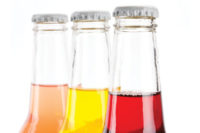Coloring on CSPI Radar
February 16/Washington/States News Service -- The "caramel coloring" used in Coca-Cola, Pepsi, and other foods is contaminated with two cancer-causing chemicals and should be banned, according to a regulatory petition filed by the Center for Science in the Public Interest (CSPI).
"In contrast to the caramel one might make at home by melting sugar in a saucepan, the artificial brown coloring in colas and some other products is made by reacting sugars with ammonia and sulfites under high pressure and temperatures,"a CSPI release explained. "Chemical reactions result in the formation of 2-methylimidazole and 4 methylimidazole, which in government-conducted studies caused lung, liver, or thyroid cancer or leukemia in laboratory mice or rats.
"The National Toxicology Program, the division of the National Institute of Environmental Health Sciences that conducted the animal studies, said that there is 'clear evidence' that both 2-MI and 4-MI are animal carcinogens. Chemicals that cause cancer in animals are considered to pose cancer threats to humans. Researchers at the University of California, Davis, found significant levels of 4-MI in five brands of cola."
"Carcinogenic colorings have no place in the food supply, especially considering that their only function is a cosmetic one," said CSPI executive director Michael F. Jacobson. "The FDA should act quickly to revoke its approval of caramel colorings made with ammonia."
Federal regulations distinguish among four types of caramel coloring, two of which are produced with ammonia and two without it. CSPI wants the FDA to prohibit the two made with ammonia. The type used in colas and other dark soft drinks is known as Caramel IV, or ammonia sulfite process caramel. Caramel III, which is produced with ammonia but not sulfites, is sometimes used in beer, soy sauce, and other foods.
CSPI also says the phrase "caramel coloring" is misleading when used to describe colorings made with ammonia or sulfite. The terms "ammonia process caramel" or "ammonia sulfite process caramel" would be more accurate, and companies should not be allowed to label any products that contain such colorings as "natural," according to the group.
"Most people would interpret 'caramel coloring' to mean 'colored with caramel,' but this particular ingredient has little in common with ordinary caramel or caramel candy," Jacobson said. "It's a concentrated dark brown mixture of chemicals that simply does not occur in nature. Regular caramel isn't healthful, but at least it is not tainted with carcinogens."
In a regulatory proceeding in California, state health officials have added 4 MI to the state's list of "chemicals known to the state to cause cancer." Under that state's Proposition 65, foods or other products containing more than certain levels of cancer-causing chemicals must carry warning labels. For 4-MI, that level is 16 micrograms per person per day from an individual product. Popular brands of cola contain about 200 micrograms of 4-MI per 20-ounce bottle-and many people, especially teenaged boys, consume more than that each day. If California's regulation is finalized, Coke, Pepsi, and other soft drinks would be required to bear a cancer warning label.
To put the risk from caramel coloring in context, CSPI says the ten teaspoons of obesity-causing sugars in a non-diet can of soda presents a greater health risk than the ammonia sulfite process caramel. But the levels of 4-MI in the tested colas still may be causing thousands of cancers in the U.S. population.
Separate from the risk due to caramel coloring, CSPI has been urging the FDA to ban synthetic food colorings, such as Yellow 5 and Red 40, complaining those dyes cause hyperactivity and other behavioral problems in children, and Red 3 and Yellows 5 and 6 pose cancer risks, according to CSPI. The FDA is holding a Food Advisory Committee review of that issue on March 30-31.
From the February 21, 2011, Prepared Foods E-dition
Looking for a reprint of this article?
From high-res PDFs to custom plaques, order your copy today!





